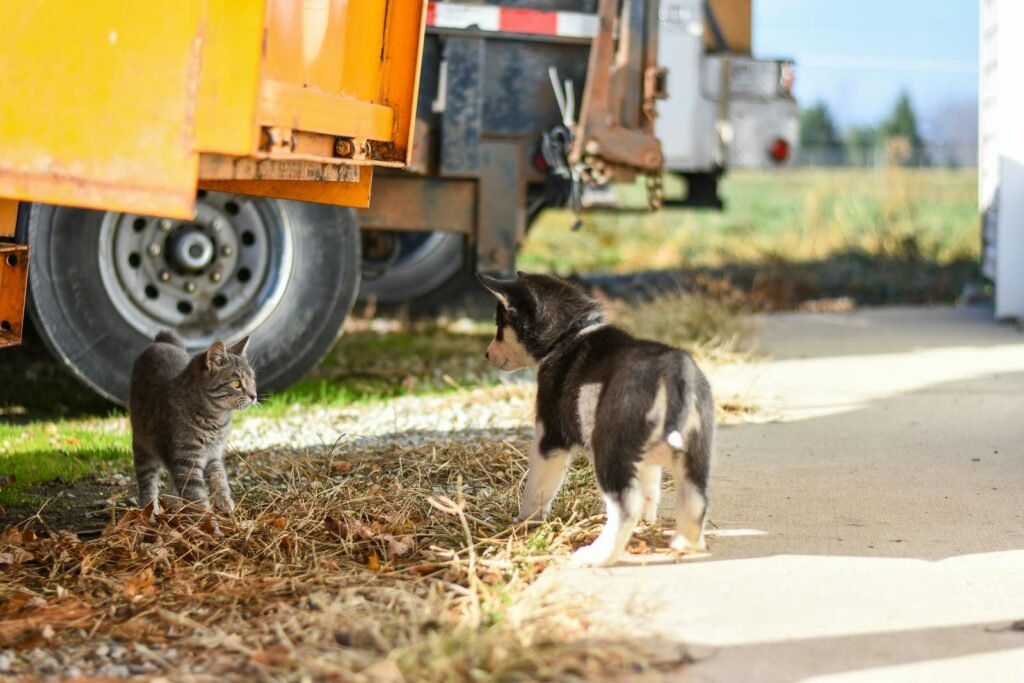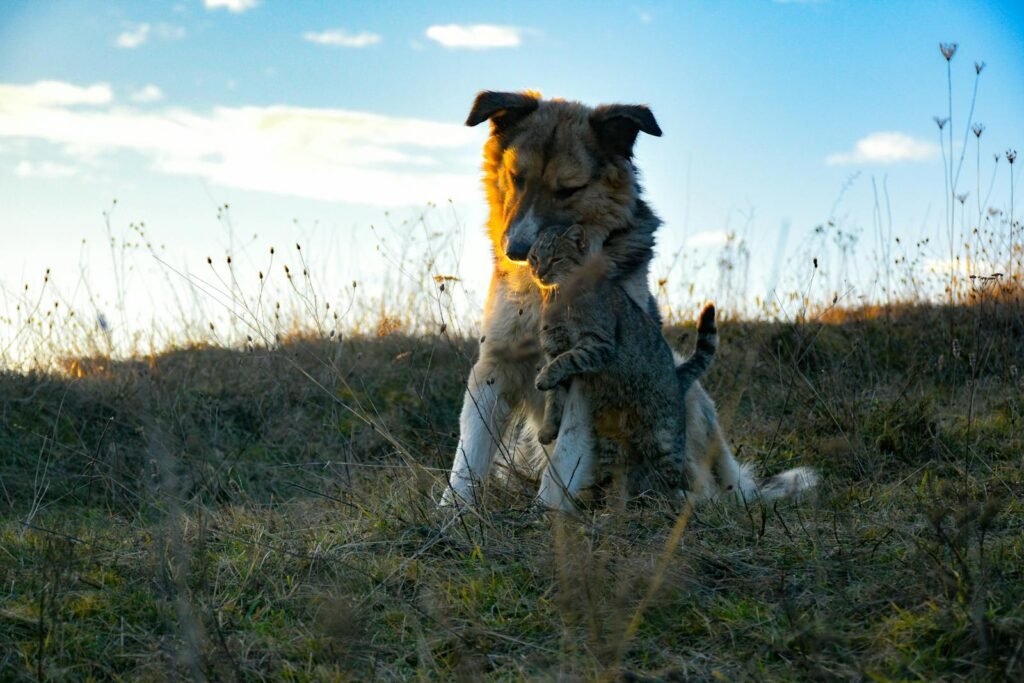Imagine the moment: a fluffy cat stretches on the rug while a bouncy dog circles nearby, tails twitching, eyes locked. Sometimes, what follows is pure magic—a fast friendship that melts even the coldest heart. Other times, there’s only hissing, barking, and a standoff that never ends. What’s behind these surprising animal encounters? Is it fate, personality, or something deeper that decides whether dogs and cats become best friends or lifelong rivals? Let’s explore the hidden world behind those first meetings and lifelong connections, celebrating every moment of feline and canine curiosity, caution, and companionship.
The Magic of First Impressions

When a dog and cat cross paths for the first time, the air is thick with anticipation—much like two strangers sizing each other up at a party. Their body language tells a story: ears perked, tails stiff or wagging, eyes wide and alert. Some animals display instant curiosity and approach with gentle sniffs, while others retreat or freeze. The first few seconds set the tone for everything that follows. It’s a dance of caution, hope, and sometimes, pure luck.
Personality: The Secret Ingredient

Just like people, every dog and cat has its own unique personality. Some are bold explorers, eager to make friends, while others are shy, preferring solitude or slow introductions. Outgoing cats might rub against a dog’s legs, while timid pups might hide behind their owner. When personalities click—think a laid-back dog meeting a confident cat—magic happens. When they clash, patience is needed.
The Role of Early Socialization

Early experiences shape how dogs and cats view the world. Animals exposed to different species during their formative weeks often grow up more open and tolerant. A kitten raised with puppies may see dogs as companions, not threats. Similarly, a puppy who meets gentle cats learns respect. These first lessons last a lifetime, influencing every future encounter.
The Power of Scent

For both dogs and cats, scent is a language all its own. Before a friendly pounce or gentle paw swipe, there’s an invisible exchange of smells. They investigate each other’s scent with cautious sniffs, learning crucial information: friend, foe, or something in between? Sometimes, swapping blankets or toys before a meeting can ease nerves and spark curiosity.
Body Language: The Silent Conversation

A cat’s arched back or a dog’s wagging tail speaks volumes. Their bodies reveal excitement, fear, or cautious optimism. Slow blinks from a cat or a playful bow from a dog often signal peaceful intentions. Reading these silent cues helps prevent misunderstandings and builds trust over time. It’s all about listening with your eyes.
Territory: Home Turf Mysteries

Cats are notorious for guarding their space, while dogs may be more open—unless their food or favorite toy is involved. Bringing a new animal into a pet’s domain can trigger anxiety or defensive behaviors. Neutral territory, like a quiet room or backyard, can help level the playing field. Sometimes, a simple change of scenery is all it takes to break the ice.
Age Matters: Kitten and Puppy Encounters

Youthful curiosity is a powerful icebreaker. Kittens and puppies tend to be more adaptable and open to new experiences. Their playful antics often bypass adult caution, leading to fast friendships. Older animals, set in their ways, may need extra time and gentle encouragement to accept a new companion.
Breed Differences: Nature’s Surprises

Some breeds are more predisposed to harmony than others. Easygoing dog breeds like Golden Retrievers or gentle cats like Ragdolls often make smooth introductions. Meanwhile, highly territorial or high-energy breeds may need careful supervision. But there are always exceptions—sometimes the most unlikely pairs become inseparable.
Fear and Past Trauma

Previous negative experiences leave deep marks. A dog chased by cats as a puppy or a cat frightened by barking dogs may react with fear or aggression. Healing takes time, patience, and positive reinforcement. Every small victory—a shared nap, a quiet meal—builds confidence and trust.
Play Styles: The Joy of Games

Play is a universal language, but not all animals play the same way. Cats love stalking and pouncing, while dogs might prefer fetching or wrestling. When play styles match, friendships blossom. When they clash, frustration can grow. Watching and gently guiding their games can turn awkward encounters into joyful memories.
Food and Treats: Sharing or Squabbling?

Food is often a flashpoint. Some animals are happy to share, while others guard their meals fiercely. Feeding pets separately at first can prevent jealousy and build positive associations. Over time, shared snacks or treats become symbols of trust and togetherness.
Communication Barriers

Dogs bark, cats meow, and sometimes their messages get lost in translation. What’s friendly to one species may seem threatening to the other. A wagging tail in a dog means excitement, but a twitching cat’s tail can signal annoyance. Learning to interpret each other’s signals takes patience—and sometimes a sense of humor.
Supervision: The Human Touch

Humans play a crucial role in guiding dog-cat relationships. Calm, attentive supervision during early meetings reassures both animals. Gentle encouragement, positive reinforcement, and timely intervention prevent misunderstandings. A watchful eye can make all the difference.
Routine and Consistency

Animals thrive on routine. Predictable feeding times, regular play sessions, and consistent rules help foster a sense of security. When dogs and cats know what to expect, anxiety fades and curiosity grows. Consistency turns strangers into housemates, and housemates into friends.
Respecting Boundaries

Some cats and dogs need their own space. Cozy beds, high perches, or quiet corners offer safe retreats. Respecting these boundaries prevents stress and teaches animals that safety and comfort matter. Over time, these safe spaces become launching points for exploration and connection.
The Sound of Friendship

Purring, chirping, and gentle woofs can signal acceptance and contentment. The sounds pets make around each other reveal their feelings. Soft vocalizations often mean trust, while silence or loud noises can signal discomfort. Listening closely to these sounds helps humans nurture healthy bonds.
Emotional Intelligence in Pets

Some animals seem to have an uncanny ability to read emotions—in both people and other pets. A sensitive dog might comfort a nervous cat, while a calm cat may soothe an excitable puppy. These moments of empathy are the building blocks of lasting companionship.
Patience: The Unsung Hero

Rome wasn’t built in a day, and neither are lasting animal friendships. Slow introductions, gentle encouragement, and lots of patience often lead to the strongest bonds. Every day brings new opportunities for trust and affection to grow.
When It Just Doesn’t Work

Not every match is meant to be. Some dogs and cats simply don’t click, no matter how hard we try. Recognizing and accepting this reality is important. Separate spaces, supervised play, or even living apart may be necessary for peace and happiness.
The Role of Enrichment

Toys, puzzles, and interactive games keep both dogs and cats engaged—and can be a bridge for bonding. Shared playtime offers opportunities for positive interaction, teamwork, and shared joy. Enrichment isn’t just fun; it’s essential for emotional health.
Health and Well-Being

A healthy pet is a happy pet. Regular vet visits, proper nutrition, and daily exercise lay the foundation for positive interactions. When animals feel their best, they’re more open to new friendships and experiences.
Cultural Legends and Stories

Throughout history, stories of unlikely animal friendships have inspired us. From ancient myths to viral videos, these tales remind us that differences can be bridged and that love knows no boundaries. Celebrating these stories brings hope and wonder to our daily lives.
Conservation and Coexistence

Learning from the bonds between dogs and cats teaches us valuable lessons about respect, patience, and coexistence. In a world where habitats shrink and resources are shared, these lessons matter more than ever. Protecting our pets and the natural world ensures a future filled with friendship and harmony.
Celebrating Every Connection

No matter how different or similar, every relationship between a dog and a cat is unique. Some become inseparable, others maintain a respectful distance, but all add a touch of magic to our lives. Watching their stories unfold reminds us of the beauty—and mystery—of animal companionship.

Growing up traveling and experiencing new cultures and wonders, I have had a passion for nature, adventuring, photography, and videography. I am currently working towards a BSc in Biodiversity and Ecology at Stellenbosch University, and I hope to specialise in Marine Sciences one day.
Please send any feedback to Feedback@animalsaroundtheglobe.com






